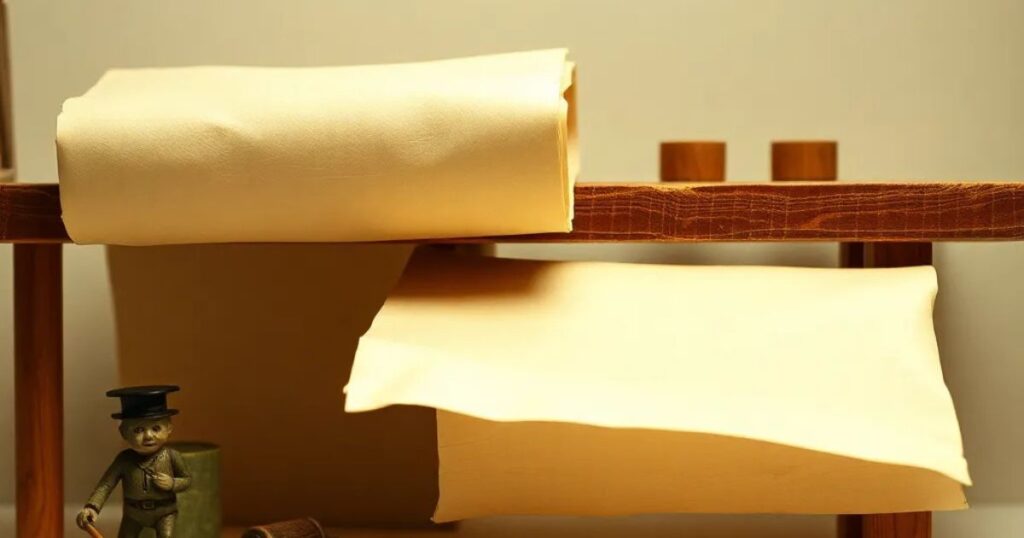In the fast-paced digital age, where communication often happens through screens, it’s easy to overlook the humble piece of paper. Paper has been the foundation of record-keeping, storytelling, education, and communication for thousands of years. Paper’s journey from its ancient origins to its modern-day presence is a fascinating story of innovation, cultural exchange, and resilience. This blog takes you through the rich history of paper, exploring its invention, spread, and the vital role it continues to play even in an increasingly digital world.
The Ancient Beginnings of Paper-Like Materials
The Ancient Beginnings of Paper-Like Materials” traces humanity’s earliest ventures into creating surfaces for writing and recording information. Long before modern paper, ancient civilizations developed unique materials from natural resources. Around 3000 BCE, Egyptians created papyrus from the pith of the papyrus plant, weaving, pressing, and drying it into sheets suitable for inscribing text. Similarly, the Chinese used bamboo and silk and invented true paper around 105 CE, revolutionizing communication and record-keeping.
Early forms of parchment made from animal hides gained popularity in other regions. These paper-like materials enabled knowledge sharing, art, and administration, forming the foundation of written history. This evolution marked a crucial step toward the paper we rely on today for expression, documentation, and when was paper invented learning.
Early Writing Surfaces
Before paper was invented, humans used various materials to record information, each with unique characteristics and limitations. Ancient Mesopotamians inscribed cuneiform on clay tablets around 3000 BCE, which were durable but cumbersome. In Egypt, papyrus—an early form of paper derived from the papyrus plant—became a widely used medium for writing. Egyptians manufactured papyrus by where was paper invented layering and pressing strips of the plant, creating a lightweight material that was relatively easy to handle compared to stone or clay.
Papyrus soon became essential for recording history, religious texts, and administrative records. However, it wasn’t widely available outside of Egypt, making it a luxury item in other cultures. As a result, civilizations like Greece and Rome turned to parchment and vellum—writing surfaces made from animal hides, typically sheep, goats, or calves. Parchment and vellum were durable and could be rolled or bound, laying the groundwork for the concept of books. Yet, these materials were costly, time-consuming to produce, and exclusive to the wealthy or institutions like the church and invention of paper government.
China’s Contribution: The Invention of True Paper

The first true paper was created in China around 105 CE by Cai Lun, a court official during the Han Dynasty. Unlike previous materials, which were limited in availability or difficult to make, Cai Lun’s invention was revolutionary. He developed a process using natural fibers—mulberry bark, hemp, old rags, and fishing who invented paper nets—pounded into a pulp, then spread onto a flat screen, pressed, and dried. The result was a lightweight, easily produced material that could be written on, folded, and stored.
This early Chinese papermaking method was a turning point in history. By creating a more accessible and versatile medium, Cai Lun had unknowingly set the stage for a knowledge revolution. His invention quickly gained popularity within China, facilitating the recording of literature, religious texts, and government documents. Although initially reserved for the elite, paper gradually became accessible to common people, transforming China’s where did paper originate cultural landscape.
Spread of Paper Through Asia
As paper production techniques spread, neighboring countries like Korea and Japan adopted and adapted these methods. Making “washi” paper in Japan became highly specialized, with artisans using local materials like the kozo plant (mulberry). Washi paper was known for its strength and beauty, and it remains a revered art form in Japan today. This period marked the beginning of when the paper was invented paper as a medium that could be tailored to fit the needs and aesthetics of different cultures.
The Spread of Paper to the Islamic World and Europe
The spread of paper from China to the Islamic world and Europe revolutionized communication, record-keeping, and knowledge-sharing across cultures. First invented in China around 105 AD, paper made its way westward along the Silk Road, reaching the Islamic world by the 8th century after Muslim forces captured Chinese papermakers in the Battle of Talas. This new, accessible material quickly replaced costly parchment and papyrus, fueling advancements in literature, science, and administration.
Islamic scholars developed techniques for mass-producing paper, establishing paper mills in cities like Baghdad and Damascus. By the 11th century, paper reached Europe, enabling the growth of universities, paper invention the spread of religious texts, and the printing press, which catalyzed the Renaissance and the wider dissemination of knowledge.
The Battle of Talas and Paper’s Spread
The year 751 CE marked a pivotal moment in the history of paper. During the Battle of Talas between the Chinese Tang Dynasty and the Abbasid Caliphate, Chinese papermakers were captured by the Arabs. This event is often credited as the moment paper-making knowledge spread beyond China. The captured papermakers were brought to Samarkand, a city that soon became an important center of paper production in the Islamic when was paper invented world.
Advancements in the Islamic Golden Age
The Islamic world enthusiastically embraced paper, recognizing its value for documentation, learning, and culture. Paper production centers were established in cities like Baghdad, Damascus, and Cairo, and Islamic scholars refined the papermaking process, producing a finer, more durable material than the original Chinese paper. The rise of paper in the Islamic world played a crucial role in preserving and advancing knowledge, particularly in science, philosophy, and mathematics.
Paper facilitated the creation and dissemination of books, enabling the development of a vibrant literary and intellectual culture. Islamic calligraphers used paper for intricate artwork and religious texts, particularly in Persia. Paper’s portability and accessibility also allowed for an extensive exchange of ideas across the Islamic empire, ultimately influencing European culture.
Paper Enters Europe
Europe first encountered paper through the Moorish occupation of Spain, with early paper mills appearing in Spain and Italy by the 12th century. European society was initially resistant to paper, as parchment and vellum were seen as more prestigious and durable. However, as paper became more widely available and affordable, its advantages became clear.
European merchants and scholars began to use paper for business records, correspondence, and scholarly texts. The development of water-powered paper mills in Europe accelerated production, making paper more affordable and the invention of paper accessible.
The Impact of Paper on Western Culture and Knowledge

The introduction of paper to Western culture marked a turning point in knowledge dissemination, transforming societies and intellectual pursuits. Originating from China, paper-making spread through the Islamic world to Europe, where it played a pivotal role in the spread of literacy and scholarly advancements.
Its affordability and accessibility, compared to earlier mediums like parchment, made written records, literature, and scientific discoveries accessible to broader audiences. The invention of the printing press amplified paper’s impact, fueling the Renaissance, Reformation, and Enlightenment by facilitating mass communication. Libraries expanded, and education became more widespread, shaping a culture of learning and innovation. Ultimately, paper revolutionized Western civilization, fostering an era of knowledge sharing that continues to influence modern information exchange and cultural development.
The Renaissance and the Printing Press
The arrival of paper in Europe laid the groundwork for one of the most transformative inventions in human history: Johannes Gutenberg’s printing press, developed in the 15th century. Before the printing press, books were laboriously hand-copied, making them expensive and rare. The printing press, combined with affordable paper, revolutionized the dissemination of information by making books and pamphlets accessible to the broader public.
The printing press was central to the Renaissance, spreading ideas rapidly across Europe. It enabled the mass production of texts such as the Bible, scientific treatises, and philosophical works, fundamentally altering how knowledge was shared. Paper and the printing press spurred a literacy boom, changing education, science, and religion.
The Age of Exploration and Colonialism
The paper became indispensable during the Age of Exploration, as explorers documented their journeys, discoveries, and interactions with Indigenous cultures. Maps, ship logs, and scientific observations were recorded on paper, providing information for future explorers and historians. Paper allowed the spread of knowledge across continents, connecting cultures in a previously impossible way. As colonial powers expanded their reach, paper played a vital role in the administration and communication across Preserving Paper Documents empires.
Paper in the Industrial Age
Paper in the Industrial Age” marked a transformative era in the production and accessibility of paper. With the rise of steam-powered machines, paper manufacturing shifted from manual labor to mass production, significantly lowering costs and increasing output. This development made the paper a staple in the education, communication, and packaging industries.
Innovations like the Fourdrinier machine enabled continuous rolls of paper, further boosting efficiency. Using wood pulp instead of rags as the primary material also accelerated production and reduced expenses. Consequently, paper became more affordable and widespread, fueling the growth of literacy, newspapers, and printed books, which helped shape public opinion and knowledge. This period laid the foundation for modern paper industries and revolutionized information recycled papers sharing.
Advancements in Papermaking
The 18th and 19th centuries saw dramatic advancements in papermaking. The demand for paper grew exponentially with the rise of newspapers, books, and public education, leading to the invention of machines like the Fourdrinier, which automated the papermaking process. This machine allowed continuous production, moving away from the labor-intensive, single-sheet process used for centuries.
Another significant development was the shift from cotton and linen rags to wood pulp as the primary material for paper. This change made the paper more affordable and accessible, allowing newspapers and books to reach broader audiences. By the 19th century, paper had become a staple of everyday life, from personal correspondence to mass media.
The Rise of Mass Media and Education
The Industrial Revolution and the rise of paper manufacturing transformed society. Newspapers became the primary news source, and education expanded as schools relied on printed textbooks. Libraries grew as more books were produced, making literature and information available to the masses.
Paper in the Modern and Digital Age
Paper in the Modern and Digital Age” explores the role of paper amidst rapid digital transformation. Despite the shift toward digital media, Paper is still a vital tool for documentation, creativity, and communication. It offers a tactile experience that screens cannot replicate, fostering focus and a sense of permanence. Paper usage has evolved, now complemented by digital tools, bridging the gap between traditional and modern workflows.
From eco-friendly, recyclable options to high-quality, durable materials, the paper continues to serve various industries, including education, business, and art. The synergy between paper and digital tools highlights its irreplaceable value in a world increasingly relying on technology, proving paper’s adaptability and continued relevance.
The Environmental Concerns of Paper Production

As paper consumption skyrocketed in the 20th century, concerns about its environmental impact grew. Deforestation, water pollution, and energy consumption associated with large-scale paper production led to efforts to mitigate these effects. Recycling programs became more widespread, and innovations in sustainable practices, such as using alternative fibers and reducing water use, gained traction.
Today, the paper industry continues to grapple with sustainability challenges. Many companies have shifted to using recycled paper, and some have explored bamboo, hemp, and agricultural waste as eco-friendly alternatives to wood pulp.
Digitalization and the Decline of Paper
As digital technology advanced in the late 20th and early 21st centuries, paper use in some places significantly decreased. Emails replaced letters, e-books offered an alternative to print books, and digital documents became standard in business and government. The paperless movement gained momentum, with many companies and institutions encouraging digital solutions to reduce paper consumption.
Despite the shift toward digital media, the environmental impact of digital technology has also come under scrutiny. Data centers and electronic devices consume significant energy, raising questions about the sustainability of digital alternatives to paper.
The Resilience of Paper in Certain Fields
While digital technology has reduced paper usage in some areas, paper remains irreplaceable in others. Physical books remain a special place for readers who prefer the tactile experience. Many artists and designers still favor paper for sketching and drafting. Studies have shown that students often retain information better when reading from paper than screens. Paper’s adaptability and sensory appeal ensure its continued relevance in various aspects of life, even as digital alternatives proliferate.
Conclusion:
From ancient Egypt’s papyrus scrolls to modern-day notebooks and digital printing, paper has been an integral part of human civilization. Its journey from simple, plant-based sheets to the highly refined product we use today reflects humanity’s constant pursuit of knowledge, communication, and artistic expression. Though digital media has transformed our relationship with paper, it has not rendered it obsolete. Instead, paper has found a way to coexist with digital technology, adapting to new needs and uses.
FAQ:
When and Where was Paper Invented?
Paper was first invented in ancient China around 105 AD. The credit goes to a Chinese court official named Cai Lun, who introduced a process using mulberry bark, hemp, old rags, and fishnets to create a durable writing material.
What Materials Were Originally used to Make Paper?
The earliest paper was made from natural fibers, including mulberry bark, hemp, old rags, and fishnets. These fibers were mashed and combined with water, then dried in thin layers to form sheets of paper.
How did Paper Spread to Other Parts of the World?
After its invention in China, papermaking techniques spread along the Silk Road to the Middle East. In the 8th century, it reached the Islamic world, and from there, paper-making spread to Europe by the 12th century.
What was used for Writing Before the Paper?
Before paper, ancient civilizations used various materials, including clay tablets in Mesopotamia, papyrus in Egypt, parchment (made from animal skins) in the Mediterranean, and silk or bamboo slips in China.
How did the Invention of Paper Impact Society?
Paper revolutionized communication and record-keeping. It made written materials more accessible and affordable, allowing for greater dissemination of knowledge, record-keeping, and the rise of education and literacy.

